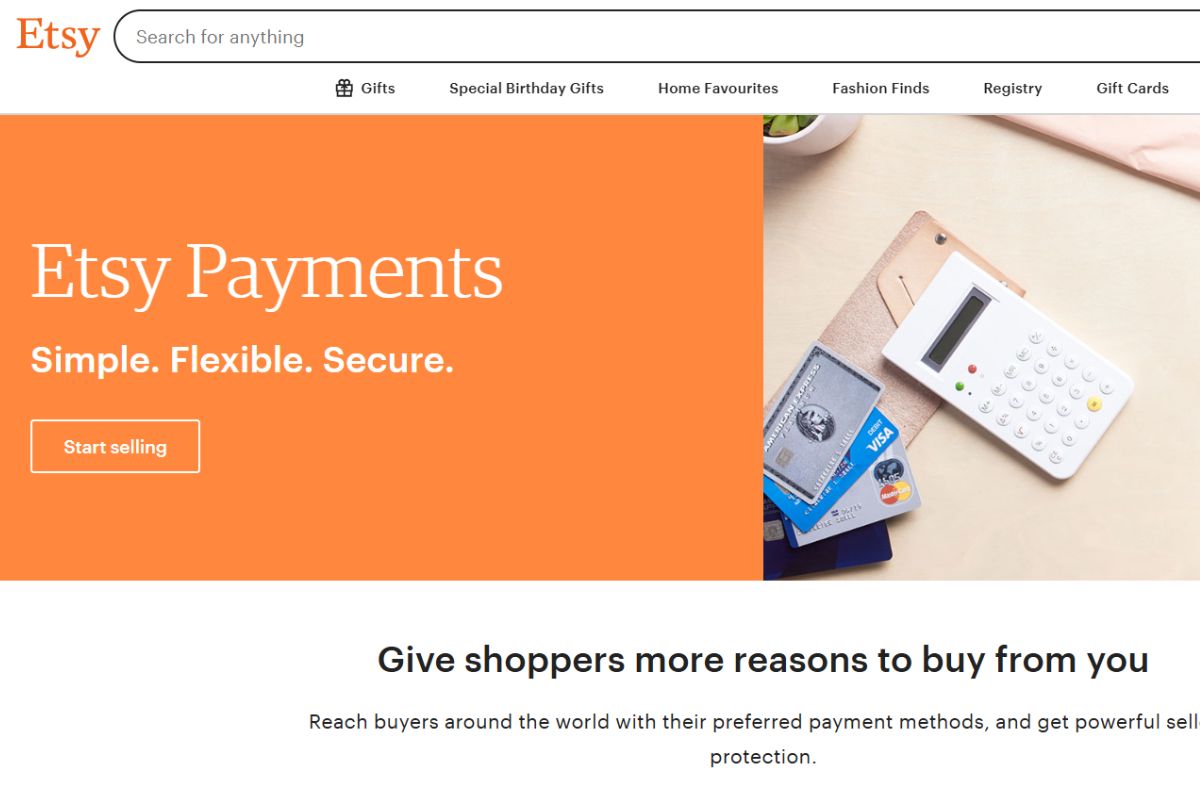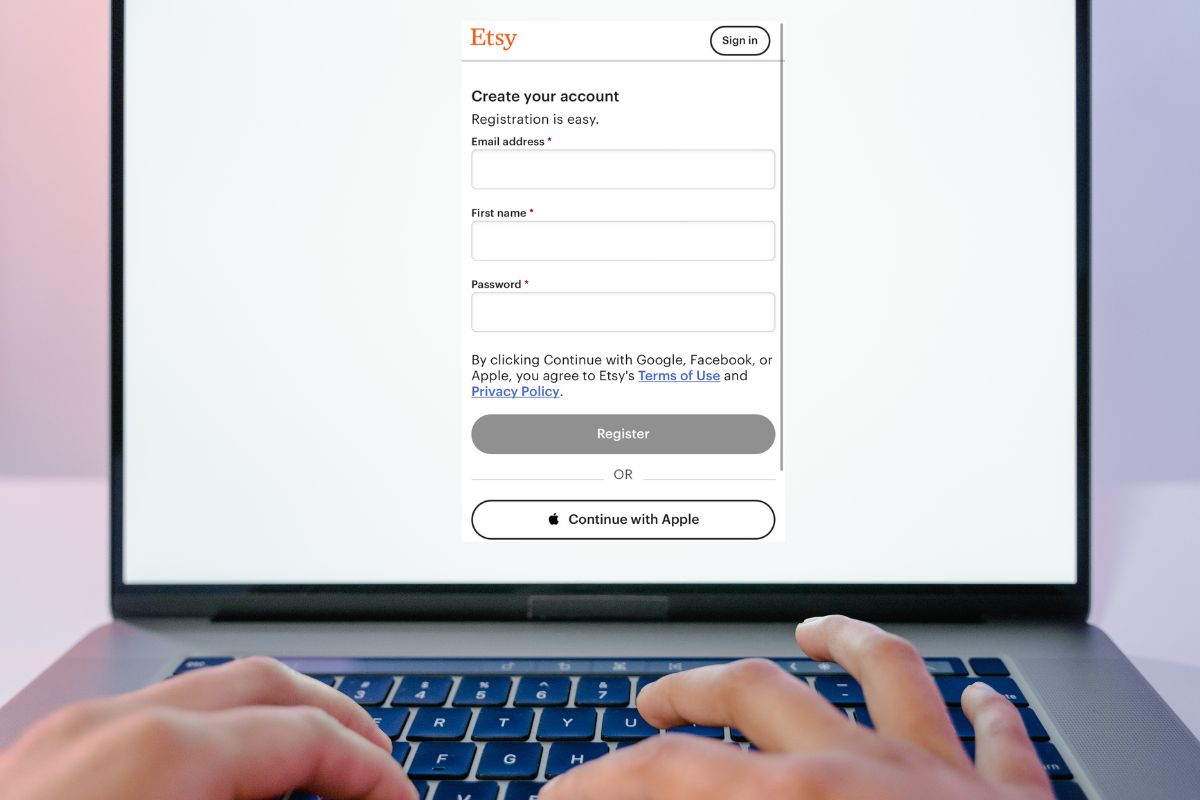If you’re excited about selling your creations on Etsy, you might wonder how old you need to be to start. You must be at least 13 years old to sell on Etsy, but you need parental permission and supervision if you are under 18.
This means that even younger teens can join this vibrant online marketplace, provided they have support from a parent or guardian.
Table of contents
- Understanding Etsy’s Platform
- Etsy’s Age Requirement Policy
- Setting Up Your Etsy Shop
- Listing Your Products on Etsy
- Financial Transactions on Etsy
- Engaging with Customers
- Promoting Your Etsy Shop
- Privacy and Security
- Collaboration and Growth
- Frequently Asked Questions
- What are the age requirements for opening an Etsy shop?
- Is parental consent required for minors to sell on Etsy?
- What identification documents does Etsy require for seller verification?
- Does Etsy enforce age restrictions for sellers?
- Can a minor legally operate an Etsy shop with parental supervision?
- Are there any age-related limitations for selling handmade goods on Etsy?
Etsy is a popular platform where millions of buyers seek unique and handmade items. Selling on Etsy can be a great way to turn your hobby into a business.
Knowing the age requirements is crucial, so you can start planning your shop and get ready to engage with a community of creative entrepreneurs.
Whether you want to sell crafts, vintage finds, or art, understanding the rules is the first step. With the right permissions and guidance, you can join the ranks of successful sellers on Etsy and share your talents with the world.
Understanding Etsy’s Platform
Etsy is a unique online marketplace designed for handmade, vintage, and unique goods.
You need to know how the platform works to start selling successfully. Key areas include navigating the marketplace, setting up your seller account, and connecting with the Etsy community.
The Etsy Marketplace
Etsy’s marketplace features a wide range of products, from handmade crafts to vintage items. This platform focuses on creativity and individuality. You can showcase your products alongside other unique sellers.
To succeed on Etsy, you must understand your target audience. Research popular items and trends on the site.
Use Etsy’s search bar to see what buyers are looking for. Make sure your listings are appealing and clear to attract customers.
Starting as an Etsy Seller
To sell on Etsy, you need to create a seller account. This involves signing up with your email and setting up a password.
You will also need to provide information about your shop, such as its name and what you will sell.
When creating your shop, be sure to add quality photos and detailed descriptions of your products. This helps potential buyers understand what you’re offering.
Check out the Seller Handbook for tips on pricing, shipping, and marketing your products effectively.
Joining the Etsy Community
Joining the Etsy community can be incredibly beneficial. The community includes sellers and buyers who share a passion for unique goods. You can connect through forums and social media groups.
Participating in forums allows you to ask questions and share experiences. You will find valuable advice from other sellers. This connection can build your confidence and improve your selling strategies.
Building relationships within the community can lead to collaborations and increased visibility for your shop. Engage regularly to stay updated on trends and Etsy news, enhancing your success on the platform.
Etsy’s Age Requirement Policy
| Age | Selling on Etsy | Conditions |
|---|---|---|
| Under 13 | Not allowed | Etsy prohibits accounts for children under 13 |
| 13-17 years | Allowed | Must have a parent/guardian manage the account and handle transactions |
| 18+ years | Fully allowed | Can create and manage an account independently |
Etsy has specific age requirements for users who want to sell on its platform. Understanding these rules is important if you or someone you know is considering starting a shop on Etsy.
Eligibility Criteria
To sell on Etsy, you need to be at least 18 years old. This age requirement is in place to ensure that sellers can enter into contracts legally.
If you are between 13 and 17 years old, you can still sell, but there are special rules. Minors must have permission from a parent or legal guardian.
A parent or guardian must register the Etsy account. This means they are responsible for all activities on the account.
If you plan to use an account for selling at a young age, make sure you follow these guidelines to avoid any issues down the line.
Minors on Etsy
For minors, Etsy’s policy allows selling under specific conditions. Minors aged 13 to 17 can create and manage shops, but only with a parent or guardian’s help.
Here are the key points regarding minors on Etsy:
- Parent Registration: Accounts must be registered in a parent’s name.
- Supervision Required: The parent or guardian must oversee all account activities.
- Financial Responsibility: All financial details, like credit cards or payment methods, must belong to the parent.
These rules help protect both the child and Etsy. Make sure to follow these guidelines to ensure a smooth selling experience.
Setting Up Your Etsy Shop
Creating an Etsy shop involves several important steps. You will need to establish your account, choose your shop’s identification, set your policies, and configure your payment and shipping settings. Each part is essential for a successful selling experience.
Creating an Account
To start, go to the Etsy website and sign up for an account. You’ll need to provide basic information like your email address and create a password.
Once you’ve registered, choose a unique username that reflects your shop’s style. If you’re a minor (under 18), ask a parent or guardian for permission. They may need to help you manage the account until you turn 18.
After setting up your account, click on “Sell on Etsy” to begin your shop setup.
Shop Identification
Your shop identity plays a crucial role in attracting customers. Start by selecting a memorable shop name. The name should be unique and represent the products you plan to sell.
Next, create a strong shop icon and banner. These visual elements help establish your brand. Use high-quality images and consistent colors. This will make your shop more appealing.
Finally, write a short, engaging shop announcement to inform visitors about your products and any special offers.
Shop Policies and About Section
Setting clear shop policies is essential. This includes your return policy, exchanges, and shipping times. Write straightforward rules that are easy to understand.
In the “About” section, share your story. Explain who you are, what inspired you, and the process behind your products. This personal touch can help build trust with potential buyers.
Include photos of your workspace or any relevant images that show your creative process.
Payment and Shipping Settings
Next, configure your payment settings. Etsy offers several options like credit cards, PayPal, and Etsy gift cards. Choose the methods that best suit your customers.
Make sure to fill in your bank information for easy payouts.
For shipping, you’ll need to set the rates and methods. Consider factors like weight, dimensions, and shipping zones.
Etsy helps calculate shipping prices, but it’s good to be familiar with standard shipping rates. You can also offer free shipping to attract more customers. Be clear about shipping times so buyers know when to expect their orders.
Listing Your Products on Etsy
| Step | Description |
|---|---|
| 1. Sign in to Your Etsy Shop | Log in to your Etsy account and go to Shop Manager. Click on Listings and then Add a listing. |
| 2. Upload High-Quality Photos & Videos | Add at least 5 images showing different angles, close-ups, and lifestyle shots. You can also add a 5-15 second video for better engagement. |
| 3. Add a Title | Write a descriptive and keyword-rich title (e.g., “Handmade Boho Macrame Wall Hanging – Large Cotton Decor”). Keep it under 140 characters. |
| 4. Write an Engaging Product Description | Clearly explain your product’s features, materials, dimensions, and how it benefits customers. Use bullet points for easy readability. |
| 5. Choose a Category | Select the most relevant category for your product (e.g., Home & Living > Wall Décor > Macrame). This helps customers find your listing. |
| 6. Set Pricing & Inventory | Enter the price, available quantity, and product variations (size, color, material, etc.). Etsy will automatically track your stock. |
| 7. Select Renewal Options | Choose manual or automatic renewal. Listings expire after four months unless auto-renewed. |
| 8. Add Shipping Details | Set your shipping price, processing time, and destination options. You can offer free shipping for better visibility. |
| 9. Set Production Partners (If Applicable) | If you work with a third-party manufacturer (e.g., Printify, Printful), disclose it in the listing. |
| 10. Preview and Publish | Review your listing for errors and publish it when ready! |
Creating effective product listings is essential for success on Etsy. You need to focus on the quality of your descriptions, visuals, and how customers can find your items. This will help you attract buyers and boost your sales.
Crafting Your Listings
When crafting your listings, the title and description are key. Use clear, descriptive titles for your products, like “Handmade Jewelry – Silver and Pearl Necklace.” This helps buyers know exactly what to expect.
In the description, include important details such as size, materials, and care instructions. Bullet points can help make this information easy to read.
Don’t forget to communicate your story; buyers love connecting with the creator.
It’s also important to set the right price. Research similar items to determine a competitive price that reflects the value of your craft. This is especially essential for handmade goods.
Product Photography Tips
High-quality product photos can make a big difference in your sales. Use natural light to take clear, well-lit images. A clean background helps your products stand out.
Aim for multiple angles. For instance, if you’re selling handmade jewelry, show close-ups of details and how it looks when worn. This gives potential buyers a better idea of what they’ll receive.
Consider adding lifestyle photos. These can show your items in use, which helps buyers imagine how they would look in their life. Always ensure images are sharp and vibrant.
Search Engine Optimization for Listings
To increase visibility, use Search Engine Optimization (SEO) techniques. Research keywords that potential buyers use when searching for products like yours.
Use these keywords in your title, description, and tags.
For instance, instead of just saying “necklace,” try “handmade silver pearl necklace.” This targets specific searches.
Remember to use all available tags. Etsy allows you to use multiple tags for each listing, so utilize them to describe items accurately. This helps your products show up in search results.
Focus on relevance and clarity to reach more buyers.
Financial Transactions on Etsy

When selling on Etsy, understanding the financial aspects is crucial. You need to manage how you receive payments and the fees that come with selling. Here’s what you should know.
Understanding Etsy Payments
Etsy uses a system called Etsy Payments for transactions. This allows buyers to pay using various methods, including credit cards, debit cards, and PayPal.
To set up Etsy Payments, you must provide your bank account details. This information is critical for receiving your earnings.
You also need to verify your identity to comply with Etsy’s policies.
Etsy Payments supports multiple currencies, making it easier to reach international buyers. You can choose to list items in your local currency or another preferred currency, which can help boost your sales.
Managing Transaction Fees
Etsy charges transaction fees for each sale you make. As of now, the standard transaction fee is 5% of the sale price.
Example of Fees:
- Sale Price: $20
- Transaction Fee: $1 (5% of $20)
In addition to the transaction fee, there’s also a listing fee of $0.20 for each item you post.
Keep these fees in mind when pricing your items, as they will impact your profit margins.
You’ll see all fees detailed in your shop’s payment account. Knowing these fees helps you plan your budget better.
Payment Processing Fees and Taxes
When you use Etsy Payments, you’ll encounter payment processing fees. These fees vary based on the seller’s location and the buyer’s payment method.
Sample Fees:
- U.S. Sellers: 3% + $0.25 per transaction
- International Sellers: Varies based on local currency.
You must also consider applicable sales taxes. Etsy automatically calculates and collects sales tax depending on the item’s location and buyer’s address.
Familiarize yourself with local tax laws to ensure compliance.
All these fees and taxes can significantly impact your earnings, so keep track of them to maintain a healthy business.
Engaging with Customers
| Engagement Strategy | Best Practices |
|---|---|
| Responding to Messages | Reply to customer inquiries within 24 hours to maintain a good response rate and build trust. |
| Personalized Customer Service | Address customers by their name and personalize responses to create a friendly interaction. |
| Handling Custom Orders | Clearly communicate timelines, customization options, and pricing for personalized products. |
| Requesting Reviews | Politely ask happy customers to leave a review; offer great service to encourage positive feedback. |
| Dealing with Complaints | Stay professional, listen to concerns, and offer a solution (replacement, refund, or discount) if necessary. |
| Following Up After Purchase | Send a thank-you message after a sale and update customers on shipping status. |
| Providing Shipping Updates | Use Etsy’s messaging system to inform customers about delays or tracking details. |
| Social Media Engagement | Share customer stories, user-generated content, and behind-the-scenes looks to build community. |
| Handling Returns & Refunds | Have a clear refund policy and resolve disputes quickly to maintain a good seller reputation. |
| Offering Discounts & Loyalty Rewards | Send discount codes to repeat customers or those who leave positive reviews. |
Engagement with your customers is key to building relationships and ensuring repeat sales. Communicating effectively and providing excellent customer service can set your shop apart.
Focus on clear messaging and thoughtful customer service strategies to create a positive experience.
Effective Communication Through Messages
Communication through messages is vital for connecting with your customers. When customers reach out, respond promptly and courteously.
- Be clear and concise: Use simple language to avoid confusion.
- Personalize your messages: Address customers by their names. This small touch shows you value them.
- Provide updates: If there are delays, let your customers know. Transparency builds trust.
You can also ask questions to gather feedback. This shows you care about their opinions and are willing to improve.
Consistent and thoughtful communication can enhance customer relationships and encourage positive reviews.
Building Customer Service Strategies
Strong customer service strategies can lead to higher satisfaction. Start by establishing a clear process for handling inquiries and issues.
- Create FAQs: List common questions and answers to help customers find information quickly.
- Have a return policy: Clearly outline your return process to avoid confusion and set expectations.
- Follow up post-purchase: Send a message after customers receive their order to ensure they are satisfied.
Use tools like social media or email newsletters to keep customers informed about new products or promotions.
Building these connections fosters loyalty and can lead to repeat business. Aim to make every interaction pleasant to encourage word-of-mouth recommendations.
Promoting Your Etsy Shop

To succeed on Etsy, it’s essential to promote your shop effectively.
Focus on leveraging Etsy Ads and understanding search engine optimization (SEO) to increase your visibility and attract more customers.
Advertising with Etsy Ads
Etsy Ads allow you to promote your listings directly to potential buyers.
You can easily set this up in your Shop Manager under the Marketing tab. Here’s how:
- Set Your Budget: Decide how much you want to spend daily. The minimum is $1.00, but you can adjust it anytime based on your sales goals.
- Choose Your Listings: Select which items you want to promote. Focus on bestsellers or those with high appeal.
- Monitor Performance: Keep an eye on how your ads are doing. Etsy provides insights that can help you tweak your strategy for better results.
Investing in Etsy Ads can lead to increased traffic to your shop and better sales.
Maximizing Visibility with SEO
SEO plays a crucial role in attracting buyers on Etsy. By optimizing your listings, you improve the chances of appearing in search results. Here are some key strategies:
- Keywords: Use relevant keywords in your titles and descriptions. Think about what customers might search for.
- Tags: Utilize all available tags. These are important for helping shoppers find your items.
- Photos and Descriptions: Ensure your photos are high quality, and write clear, engaging descriptions. This can lead to higher conversion rates.
Regularly updating your listings based on trends can also keep your shop fresh and noticeable.
By applying these SEO techniques, you will enhance your shop’s online presence.
Privacy and Security
| Privacy & Security Aspect | Best Practices |
|---|---|
| Protecting Personal Information | Avoid sharing personal contact details publicly and use Etsy’s secure messaging system. |
| Secure Payment Processing | Use Etsy Payments for secure transactions and avoid off-platform payment requests. |
| Managing Customer Data | Follow Etsy’s privacy policies and GDPR compliance to protect customer information. |
| Avoiding Scams & Fraud | Be cautious of suspicious messages, phishing emails, and fake buyer requests. |
| Setting Up Two-Factor Authentication (2FA) | Enable 2FA for added security on your Etsy account to prevent unauthorized access. |
| Handling Chargebacks & Disputes | Keep records of conversations, tracking numbers, and receipts for dispute resolution. |
| Preventing Unauthorized Account Access | Use a strong password, change it regularly, and avoid using the same password for multiple sites. |
| Reporting Security Issues | Immediately report fraudulent activity or security concerns to Etsy Support. |
| Privacy Settings for Listings | Use private listings when necessary and avoid disclosing sensitive supplier details. |
| Understanding Etsy’s Seller Protection | Review Etsy Seller Protection Policy to ensure coverage for eligible transactions. |
When you sell on Etsy, protecting your privacy and security is important. Here are key points to keep in mind:
Account Information: You must provide accurate personal information when creating your account. This includes your email address, which helps Etsy communicate with you about your sales.
Financial Information: Etsy securely handles your financial information. You need to enter your payment details to process transactions. Make sure to use a secure password for your account.
Parental Supervision: If you are under 18, your parent or legal guardian will supervise your account. They are responsible for all activities related to your shop, which adds an extra layer of security.
Privacy Settings: Etsy offers options to manage your privacy settings. You can adjust who sees your profile and your shop details to keep your personal information safe.
Data Protection: Etsy follows laws to protect your personal data. They work to prevent unauthorized access to your account and information.
Collaboration and Growth

Collaboration plays a vital role in growing your Etsy shop. By joining teams and engaging with the Etsy community, you can connect with other sellers, share tips, and access resources that can enhance your business.
Joining and Forming Teams
Etsy offers teams that allow sellers to connect based on shared interests or goals. You can join a team that aligns with your shop’s focus, whether that’s handmade crafts, vintage items, or supplies.
Benefits of Joining a Team:
- Networking: Meet other sellers and expand your contacts.
- Resources: Access guides, tools, and promotional opportunities.
- Support: Gain encouragement and advice from experienced members.
You can also consider forming your own team. This can create a community tailored to your specific niche and business goals.
By facilitating discussions and activities, teams enable collective growth and learning.
Leveraging Seller Forums and Events
The Etsy community hosts online forums where you can ask questions and share experiences. Participating in these forums allows you to learn from the successes and challenges of others.
Key Aspects of Forums:
- Knowledge Sharing: Gain insights on pricing, marketing, and shipping.
- Feedback: Get opinions on products and customer service improvements.
Additionally, Etsy often organizes events, both online and in-person, where sellers can connect. Attending these events can help you learn new strategies and showcase your products to a broader audience.
Incorporating collaboration into your Etsy journey can significantly enhance your growth potential.
Frequently Asked Questions
You may have questions about age requirements and the rules for selling on Etsy as a minor. Below are common inquiries regarding this topic.
What are the age requirements for opening an Etsy shop?
To open an Etsy shop, you need to be at least 13 years old. Minors between 13 and 17 can sell, but they must have permission from a parent or guardian.
Is parental consent required for minors to sell on Etsy?
Yes, parental consent is required for minors aged 13 to 17. Your parent or legal guardian must supervise your account and register it with their information.
What identification documents does Etsy require for seller verification?
Etsy may ask for identification documents to verify your account. This could include your parent’s or guardian’s identification since they will be responsible for the account.
Does Etsy enforce age restrictions for sellers?
Yes, Etsy enforces age restrictions. They ensure that minors under 13 are not allowed to create accounts or sell on the platform.
Can a minor legally operate an Etsy shop with parental supervision?
Yes, a minor can legally operate an Etsy shop if they are supervised by a parent or legal guardian. The adult must oversee everything related to the account.
Are there any age-related limitations for selling handmade goods on Etsy?
The primary limitation is that sellers must be at least 13 years old. Minors aged 13 to 17 need permission and supervision to sell handmade goods.



